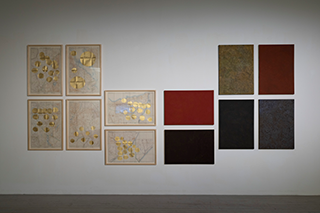
Giulia Piscitelli, Borraccia futurista 2020
alluminio, cuoio | aluminum, leather
Giulia Piscitelli, ex Padiglione della Civiltà cristiana in Africa 1995/2022
stampa su carta | print on paper
Courtesy dell’artista e Galleria Fonti | Courtesy of the artist and Galleria Fonti

Giulia Piscitelli, Incoronazione della Vergine tra angeli e santi 2022
foglia d’oro su carta | golden leaf on paper
Commissionato per Bellezza e Terrore: luoghi di colonialismo e fascismo | Commissioned for Beauty and Terror: sites of colonialism and fascism
Collezione Fondazione Donnaregina per le arti contemporanee – Museo Madre | Collection of Fondazione Donnaregina per le arti contemporanee – Museo Madre
Terra, sistema periodico #01 2022
verde ossido, verde Nicosia, rosso Veneto, verde calce, giallo ossido, rosso Pozzuoli, ombra naturale | green oxide, Nicosia green, Venetian red, lime green, yellow oxide, Pozzuoli red, umber
Terra, sistema periodico #02 2022
blu Ercolano, cinabro, nero Roma, giallo ossido, ombra naturale, verde ossido | blue Herculaneum, cinnabar, Roman black, yellow oxide, umber, green oxide
Terra, sistema periodico #03 2022
terra bruciata, siena naturale, terra verde, caput mortuum, blu indatrene, ombra naturale | burnt sienna, natural sienna, green earth, caput mortuum, indanthrone blue, natural umber
Terra, sistema periodico #04 2022
Verde ossido, verde Nicosia, rosso pozzuoli, siena naturale, nero Roma, ombra naturale | green oxide, Nicosia green, Pozzuoli red, natural siena, Roman black, natural umber
Terra, sistema periodico #05 2022
caput mortuum, siena bruciata, nero roma, cinabro, ombra naturale, giallo ossido, ombra bruciata, caput mortuum, rosso cadmio scuro | caput mortuum, burnt sienna, Roman black, cinnabar, natural umber, yellow oxide, burnt umber, caput mortuum, dark cadmium red
Terra, sistema periodico #06 2022
ocra, nero Roma, rosso Veneto, ombra naturale, ombra bruciata, verde ossido, caput mortuum | ochre, Roman black, Venetian red, natural umber, burnt umber, oxide green, caput mortuum
Commissionato per Bellezza e Terrore: luoghi di colonialismo e fascismo | Commissioned for Beauty and Terror: sites of colonialism and fascism
Courtesy dell’artista e Galleria Fonti | Courtesy of the artist and Galleria Fonti
Photo © Amedeo Benestante
The work is a result of a research on the connections between the earth and the sky, in particular the connections between a proportion of the real and a divine proportion. The proportion of the real is provided by the reduction scales of the geographic maps (published by the Consociazione Turistica Italiana, Africa Orientale Italiana in 1938) that are used as a support for the work, while the divine proportion is provided the disposition of the haloes on Leonardo di Michelino da Besozzo’s ‘Incoronazione della Vergine tra angeli e santi’ (1440 – 1450), a fresco that decorates the Church of San Giovanni a Carbonara, a few steps away from the museo Madre. The haloes on the maps are reproduced with the gold leaf technique, like in the original fresco. The dated geographical map highlights the historical changes of the territorial borders produced by humans throughout political contexts, or by geological contingencies.
A virtual time journey manifests itself. The art history of the 11th and 16th centuries clearly depicts through the iconography of the halo the representative symbol of the divine. The halo is an iconographic element that has been used since ancient times, not only in Christian history, as demonstrated by the representations of the three deities Baalshamin, Aglibol and Malakbel in the city of Palmyra in Syria. These works are realized by subtracting haloes from the characters in some masterpieces of ancient art from monasteries, miniatures, frescoes, and tempera paintings on wood. The protagonists of these works are represented in the absence of their bodies, in their auratic conditions. Almost all these old maps are made with light colours, such as pink, green, pastel blue, they seem to be made by children for children. The position of these golden circles, could remind one of locations for a Risiko-type military strike or air attack, but conversely, also a resilient landscape.
– Giulia Piscitelli